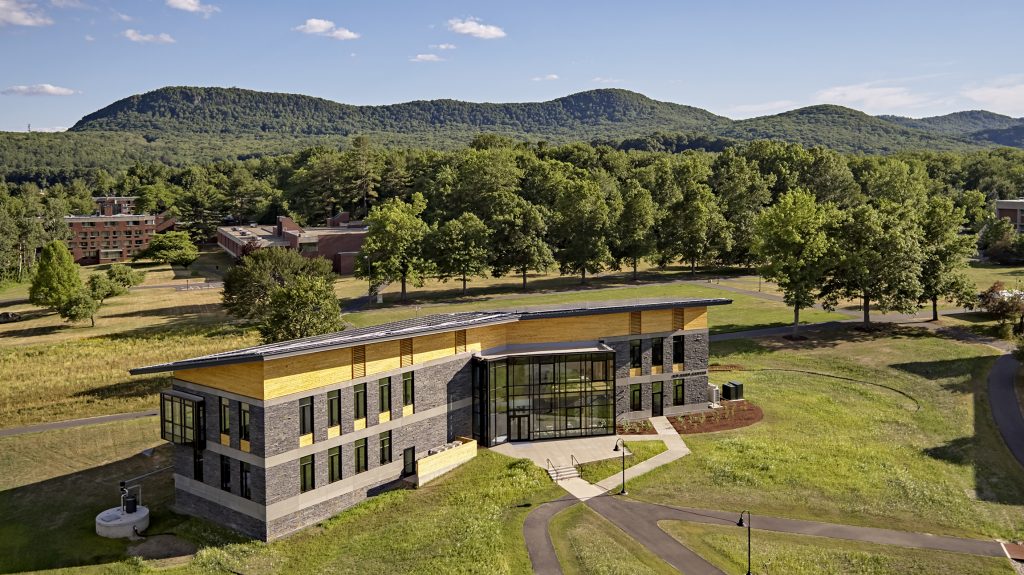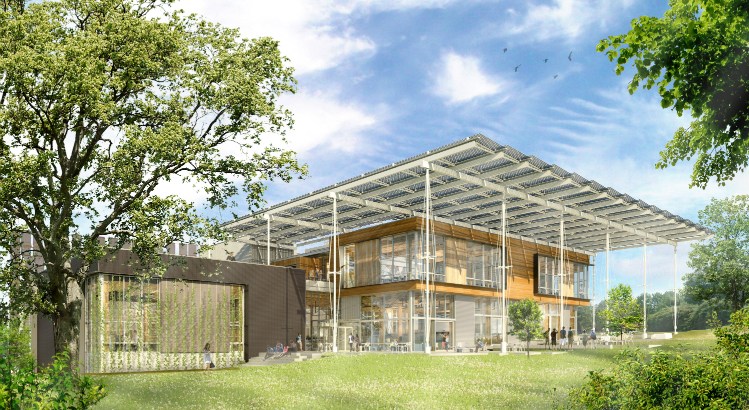We Are Made For This: The Opportunity of Regenerative Design in Higher Education
Colleges and universities are known as cultivators of revolution, challenging the status quo in pursuit of a better world. In the 1960’s, American universities were hotbeds of student activism, demanding equal rights, environmental stewardship, and policies of peace. Today, another revolution is brewing in higher education: a revolution of place. In an era of climate crisis, social injustice, and increased health risks, colleges and universities are stepping up, tackling these issues on campus through their built environments.
As one of the most significant financial and legacy investments a college can make, campus infrastructure offers a huge opportunity to deliver positive change. What if every building or renovation project could positively impact a college’s community, environmental footprint, and educational mission?
A growing pool of institutions is taking up the Living Building Challenge (LBC) as a way to leverage their built environments for positive change. Our organizations, Hampshire College and Georgia Institute of Technology, turned to the LBC and its central question- “what does good look like?” – for our campuses, our students, and our global community.
Leading the Way
It’s no coincidence that LBC values are finding fertile ground in higher ed. For many colleges and universities, making a positive impact is an integral part of our institutional mission and strategy. Hampshire College strives to “foster a lifelong passion for learning, inquiry, and ethical citizenship that inspires students to contribute to knowledge, justice, and positive change in the world.” Georgia Tech students are taught to “be leaders in improving the human condition in Georgia, the United States, and around the globe” through a motto of “progress and service.” Fundamentally, the purpose of higher education is to serve our students: their growth, knowledge, and capacity to contribute to a thriving society. We must lead by example to prepare our students for a changing world. This leadership is not mere altruism – it is critical for students’ future success.
Higher education institutions have been leaders in sustainability for decades: implementing comprehensive waste reduction systems, supporting local and sustainable food systems, building LEED facilities, and pursuing carbon neutrality as part of a global effort to combat climate change. Now, it is time to push further, leveraging our reputation as leaders to drive a revolution in regenerative building practices. This work can both drive and support campus sustainability missions, contributing to carbon reduction goals and providing inspiration and structure for more ambitious action.
Our impacts do not stop at our campus boundaries. Many colleges and universities are the largest real estate holders in their area; Georgia Tech’s campus represents over 400 acres and 200 buildings within the urban core of the City of Atlanta. Done well, institutional success in creating transformative built environments is amplified in the community, creating a local model of what good buildings look like and a new framework for mutually beneficial “town and gown” relations.
We are made for this. As largely non-profit organizations, higher education institutions are able to think beyond short-term return on investment, focusing instead on the long-term value that buildings add to our campus infrastructure and culture. As owners and operators, we have a strong incentive to invest in operational efficiency, high-quality materials, and thoughtful design – and to reap the benefits for decades to come. At Georgia Tech, the administration challenges the Institute to think in terms of a “1000-year campus.” This ability to think holistically about the built environment primes higher education institutions to lead in sustainable design and building, and leverage that leadership for greater impacts in fundraising, teaching, learning, community engagement, and ultimately, legacy.
What Good Looks Like
In 2013, Hampshire College hadn’t built a new building in almost 30 years. When the time came to create a new admissions space and gateway to campus, the possibilities were wide open. Then-president Jonathan Lash championed a building and process that would support Hampshire’s tradition of environmental stewardship, innovation, experiential education, and its mission “to respond to the challenges of the twenty-first century by graduating adaptive entrepreneurs of change.” The result was the R.W. Kern Center.
During construction in 2015, three professors at Hampshire—a hydrologist, microbiologist, and mathematician—together designed a new Integrated Sciences First-Year Program (ISFP) around the Kern Center’s systems. Spurring curricular innovation and student research, students explored the building’s net-zero water system including a greywater treatment system, creating mock-ups of the constructed wetlands, measuring water quality, and scaling their findings using computational models. Several students from the inaugural class went on to win a national water filtration design challenge, using what they had learned in their own experiments. One of these students is now continuing her research as a year-long senior capstone project. Another went on to study the Kern Center’s energy systems, published his findings, and now works as a building energy data analyst, a job he secured before graduation.
At Georgia Tech, the Kendeda Building is the answer to a 1000-year campus challenge. The building’s Academic & Research Council provides grants for faculty and students to incorporate the building’s concepts into classes, research, and community pilot projects. Tapping into the campus’ innovation culture, one project supports a multi-disciplinary student cohort to develop user experience platforms that help occupants contribute to the building’s continuous health and performance. Other student ideas include gaming tools for occupants to earn rewards for positive actions, as well as visualizing health and happiness of the building through sound, ambient lighting, and colors. Another project developed outreach curriculum that incorporates the Kendeda Building into the State of Georgia’s K-12 teaching standards, not only educating the next generation in how nature and science can help solve complex design challenges but also providing an accessible way for students to virtually “visit” the building from their classroom.
These projects represent only a few initial examples of how our LBC projects facilitate the advancement of student, community and visitor learning. Hampshire and Georgia Tech anticipate an exponential growth of impactful learning opportunities to students and our communities over the lives of our facilities.
Collaborative leadership in sustainability and regenerative principles has inspired new opportunities for funding. Georgia Tech’s Academic & Research Council has used the Kendeda project as the basis for pursuing grants and developing inter-disciplinary partnerships to better support future funding opportunities. At Hampshire, two science professors who use the Kern Center in their classes have received outside funding to expand on their work, collaborating with other LBC projects to develop new interdisciplinary curricular models in social science, art, policy, and more.
Our LBC projects support and enhance our existing sustainability goals, spur collaboration, and reinforce our campuses as living learning laboratories. Since the schematic design phase, the operations and maintenance staff at Georgia Tech have used the campus to test LBC standards through the implementation of pilot projects. Staff learned LBC criteria and gained experience operating to LBC standards across landscapes, green cleaning, thermal comfort, and zero waste. The projects helped reinforce the team’s already-existing leadership, such as a decade-long commitment to healthy cleaning standards, and they inspired new opportunities to extend these operational changes to other areas of campus. At Hampshire, the Kern Center project inspired several campus-wide changes. Following the success of the Kern native wildflower meadow, the college has transitioned more acreage to native meadowland, reducing maintenance costs and creating new pollinator habitat. The Kern Center’s rooftop solar array was developed alongside a project to install enough solar arrays on campus to supply the college’s entire electricity needs, bringing the college much closer to its goal to be carbon neutral by 2022.
The partnerships that developed out of our projects have enriched our capacity for collaboration and connection. At Hampshire, students now have access to a pool of engineers, builders, and architects who are invested in the school’s educational and environmental mission. These professionals offer their expertise, and in turn, tap into our students’ and professors’ research. Together, this growing knowledge community is collaborating to improve the Kern Center’s on-site water treatment system, and sharing their experience with others in industry journals and at national conferences. Georgia Tech is working with the Healthy Building Network, Google, Harvard, Perkins + Will, MSR Design and the Durst Organization to test a healthy materials resource database called Portico. This work will shed light on how building products impact human and environmental health.
Georgia Tech’s Equity Working Group, comprised of students, faculty, community partners, and the project team, instigated a partnership between the project contractor and Georgia Works, a non-profit providing workforce development training and experiences to homeless men. In an initial program pilot, two men hired through Georgia Works built structural nail laminated timber panels, a major component of the building’s low-carbon design. The initiative has inspired other ideas to transform hiring practices in the construction industry and support skills development in people from the campus’ immediate neighborhood. In Hampshire’s community, tradespeople are bringing what they learned on the Kern Center project to their other work, using healthier, more sustainable materials.
Our projects have benefited from a large network of peers already taking on the challenge. This community is essential to our success, a feedback loop of innovation in regenerative work. The Kern Center project relied on lessons learned at the Williams College Kellogg House and the Smith College Bechtel Center. Georgia Tech was inspired and encouraged by Hampshire and the University of British Columbia. In turn, Georgia Tech is sharing their experience with Vanderbilt and Appalachian State, while Hampshire has hosted visitors from such institutions as Yale, GE, and a symposium of higher education employees and industry partners. Through this network of mutual support, each project increases our collective positive impact, a welcome alternative to the oft-cited “amenities arms race” of higher education.
Rise to the Challenge
Georgia Tech and Hampshire College are two very different institutions – a small northern, liberal arts college and a large university in a southern city. Yet, alongside many others in the higher education community, we both embrace a regenerative philosophy for our students, campuses, communities, and planet. The Living Building Challenge reinforces these values in our institutions, supporting our educational missions, partnerships, and campaigns for positive social impact.
The Living Building Challenge framework opens new possibilities for more institutions to broaden their reach in the world. If you are up for the challenge, a network of peers are ready to support you. We can’t wait to collaborate, learn from your experience, and, together, work toward a regenerative future.
Project Summaries
R.W. Kern Center, Hampshire College
- Admissions and Financial Aid offices, plus café, gallery, and commons space
- Completed Spring 2016
- 17,000 ft2
- LBC Certified, v 2.1
- https://www.hampshire.edu/discover-hampshire/rw-kern-center
Kendeda Building for Innovative Sustainable Design, Georgia Institute of Technology
- Education and research building with classrooms, labs, maker space, offices, and an auditorium
- Anticipated completion Summer 2019
- 47,000 ft2
- Pursuing LBC v 3.1
- http://livingbuilding.gatech.edu/kendeda-building-innovative-sustainable-design






